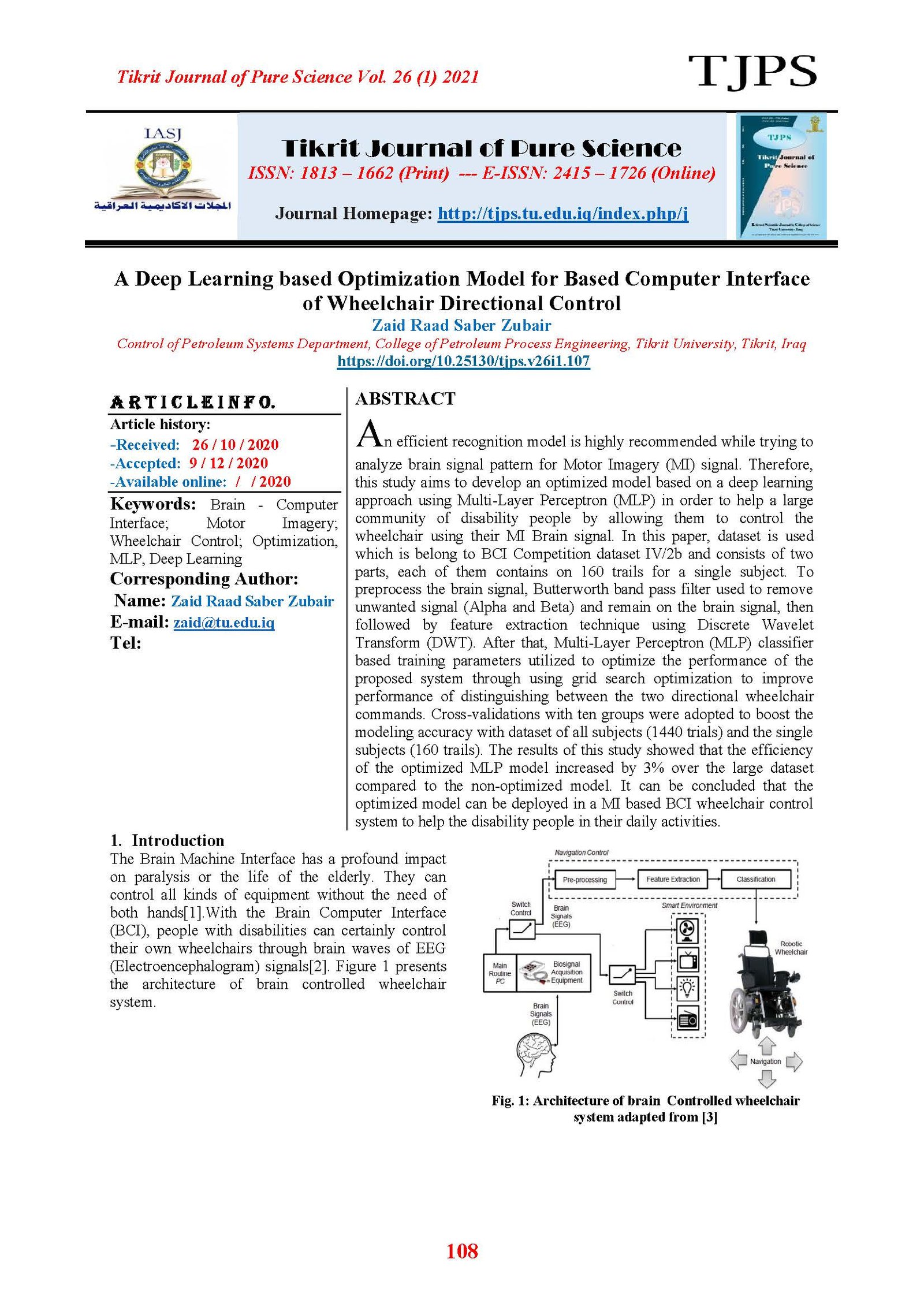A Deep Learning based Optimization Model for Based Computer Interface of Wheelchair Directional Control
Main Article Content
Abstract
An efficient recognition model is highly recommended while trying to analyze brain signal pattern for Motor Imagery (MI) signal. Therefore, this study aims to develop an optimized model based on a deep learning approach using Multi-Layer Perceptron (MLP) in order to help a large community of disability people by allowing them to control the wheelchair using their MI Brain signal. In this paper, dataset is used which is belong to BCI Competition dataset IV/2b and consists of two parts, each of them contains on 160 trails for a single subject. To preprocess the brain signal, Butterworth band pass filter used to remove unwanted signal (Alpha and Beta) and remain on the brain signal, then followed by feature extraction technique using Discrete Wavelet Transform (DWT). After that, Multi-Layer Perceptron (MLP) classifier based training parameters utilized to optimize the performance of the proposed system through using grid search optimization to improve performance of distinguishing between the two directional wheelchair commands. Cross-validations with ten groups were adopted to boost the modeling accuracy with dataset of all subjects (1440 trials) and the single subjects (160 trails). The results of this study showed that the efficiency of the optimized MLP model increased by 3% over the large dataset compared to the non-optimized model. It can be concluded that the optimized model can be deployed in a MI based BCI wheelchair control system to help the disability people in their daily activities.
Article Details

This work is licensed under a Creative Commons Attribution 4.0 International License.
Tikrit Journal of Pure Science is licensed under the Creative Commons Attribution 4.0 International License, which allows users to copy, create extracts, abstracts, and new works from the article, alter and revise the article, and make commercial use of the article (including reuse and/or resale of the article by commercial entities), provided the user gives appropriate credit (with a link to the formal publication through the relevant DOI), provides a link to the license, indicates if changes were made, and the licensor is not represented as endorsing the use made of the work. The authors hold the copyright for their published work on the Tikrit J. Pure Sci. website, while Tikrit J. Pure Sci. is responsible for appreciate citation of their work, which is released under CC-BY-4.0, enabling the unrestricted use, distribution, and reproduction of an article in any medium, provided that the original work is properly cited.
References
[1] L. Xin, S. Gao, J. Tang, and X. Xu, "Design of a Brain Controlled Wheelchair," in 2018 IEEE 4th International Conference on Control Science and Systems Engineering (ICCSSE), 2018, pp. 112-116: IEEE.
[2] J. Utama and M. Saputra, "Design of electric wheelchair controller based on brainwaves spectrum EEG sensor," in IOP Conference Series: Materials Science and Engineering, 2018, vol. 407, no. 1, p. 012080: IOP Publishing.
[3] Z. Al-Qaysi, B. Zaidan, A. Zaidan, M. J. C. m. Suzani, and p. i. biomedicine, "A review of disability EEG based wheelchair control system: Coherent taxonomy, open challenges and recommendations," vol. 164, pp. 221-237, 2018.
[4] P. J. García-Laencina, G. Rodríguez-Bermudez, and J. Roca-Dorda, "Exploring dimensionality reduction of EEG features in motor imagery task classification," Expert Systems with Applications, vol. 41, no. 11, pp. 5285-5295, 2014.
[5] J. Li, J. Liang, Q. Zhao, J. Li, K. Hong, and L. Zhang, "Design of assistive wheelchair system directly steered by human thoughts," International journal of neural systems, vol. 23, no. 03, p. 1350013, 2013.
[6] P. Bhuvaneswari and J. S. Kumar, "Support vector machine technique for EEG signals," International Journal of Computer Applications, vol. 63, no. 13, 2013.
[7] A. Ferreira, T. F. Bastos Filho, M. Sarcinelli Filho, J. L. M. Sanchez, J. C. G. García, and M. M. Quintas, "Evaluation of PSD Components and AAR Parameters as Input Features for a SVM Classifier Applied to a Robotic Wheelchair," in BIODEVICES, 2009, pp. 7-12.
[8] M. Carra and A. Balbinot, "Evaluation of sensorimotor rhythms to control a wheelchair," in 2013 ISSNIP Biosignals and Biorobotics Conference: Biosignals and Robotics for Better and Safer Living (BRC), 2013, pp. 1-4: IEEE.
[9] T. L. Fan, C. Ng, J. Ng, and S. Goh, "A brain-computer interface with intelligent distributed controller for wheelchair," in 4th Kuala Lumpur International Conference on Biomedical Engineering 2008, 2008, pp. 641-644: Springer.
[10] R. Chai, S. H. Ling, G. P. Hunter, Y. Tran, H. T. J. I. j. o. b. Nguyen, and h. informatics, "Brain–computer interface classifier for wheelchair commands using neural network with fuzzy particle swarm optimization," vol. 18, no. 5, pp. 1614-1624, 2013.
[11] R. Chai, S. H. Ling, G. P. Hunter, and H. T. Nguyen, "Toward fewer EEG channels and better feature extractor of non-motor imagery mental tasks classification for a wheelchair thought controller," in 2012 Annual International Conference of the IEEE Engineering in Medicine and Biology Society, 2012, pp. 5266-56 5269: IEEE..
[12] R. Chai, S. H. Ling, G. P. Hunter, and H. T. Nguyen, "Mental non-motor imagery tasks classifications of brain computer interface for wheelchair commands using genetic algorithm-based neural network," in The 2012 International Joint Conference on Neural Networks (IJCNN), 2012, pp. 1-7: IEEE.
[13] X. Wang, G. Gong, N. Li, and S. J. F. i. h. n. Qiu, "Detection Analysis of Epileptic EEG Using a Novel Random Forest Model Combined With Grid Search Optimization," vol. 13, 2019.
